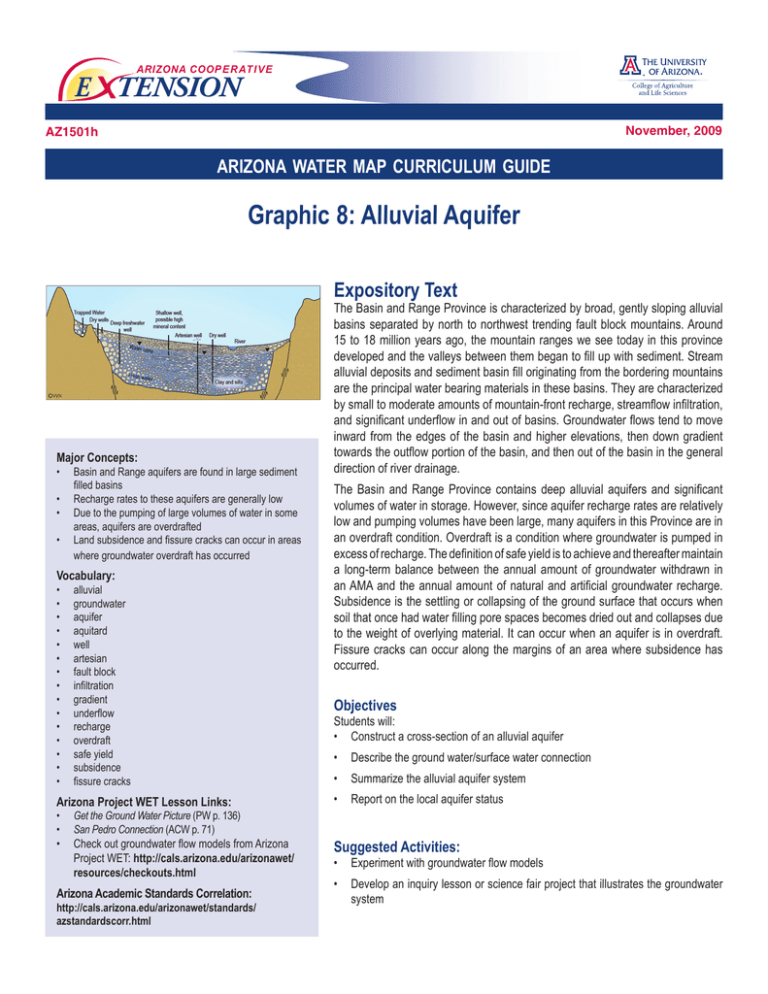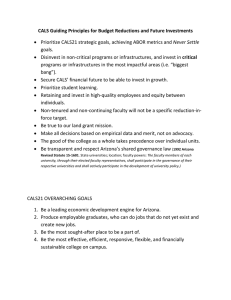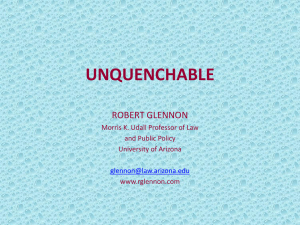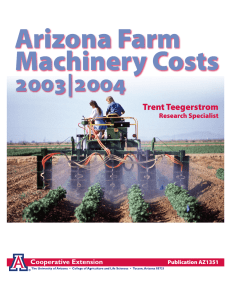E TENSION Graphic 8: Alluvial Aquifer Expository Text
advertisement

ARIZONA COOP E R AT I V E E TENSION November, 2009 AZ1501h arizona water map curriculum guide Graphic 8: Alluvial Aquifer Expository Text Major Concepts: • Basin and Range aquifers are found in large sediment filled basins • Recharge rates to these aquifers are generally low • Due to the pumping of large volumes of water in some areas, aquifers are overdrafted • Land subsidence and fissure cracks can occur in areas where groundwater overdraft has occurred Vocabulary: • • • • • • • • • • • • • • • alluvial groundwater aquifer aquitard well artesian fault block infiltration gradient underflow recharge overdraft safe yield subsidence fissure cracks The Basin and Range Province is characterized by broad, gently sloping alluvial basins separated by north to northwest trending fault block mountains. Around 15 to 18 million years ago, the mountain ranges we see today in this province developed and the valleys between them began to fill up with sediment. Stream alluvial deposits and sediment basin fill originating from the bordering mountains are the principal water bearing materials in these basins. They are characterized by small to moderate amounts of mountain-front recharge, streamflow infiltration, and significant underflow in and out of basins. Groundwater flows tend to move inward from the edges of the basin and higher elevations, then down gradient towards the outflow portion of the basin, and then out of the basin in the general direction of river drainage. The Basin and Range Province contains deep alluvial aquifers and significant volumes of water in storage. However, since aquifer recharge rates are relatively low and pumping volumes have been large, many aquifers in this Province are in an overdraft condition. Overdraft is a condition where groundwater is pumped in excess of recharge. The definition of safe yield is to achieve and thereafter maintain a long-term balance between the annual amount of groundwater withdrawn in an AMA and the annual amount of natural and artificial groundwater recharge. Subsidence is the settling or collapsing of the ground surface that occurs when soil that once had water filling pore spaces becomes dried out and collapses due to the weight of overlying material. It can occur when an aquifer is in overdraft. Fissure cracks can occur along the margins of an area where subsidence has occurred. Objectives Students will: • Construct a cross-section of an alluvial aquifer • Describe the ground water/surface water connection • Summarize the alluvial aquifer system Arizona Project WET Lesson Links: • Report on the local aquifer status • Check out groundwater flow models from Arizona Project WET: http://cals.arizona.edu/arizonawet/ resources/checkouts.html Suggested Activities: • • Get the Ground Water Picture (PW p. 136) San Pedro Connection (ACW p. 71) Arizona Academic Standards Correlation: http://cals.arizona.edu/arizonawet/standards/ azstandardscorr.html • Experiment with groundwater flow models • Develop an inquiry lesson or science fair project that illustrates the groundwater system ARIZONA COOP E R AT I V E E TENSION THE UNIVERSITY OF ARIZONA COLLEGE OF AGRICULTURE AND LIFE SCIENCES The University of Arizona College of Agriculture and Life Sciences Tucson, Arizona 85721 Kerry Schwartz Associate Specialist, Dept. of Agricultural Education, Water Resources Research Center Kristine Uhlman, RG Area Assistant Agent, Natural Resources, Water Resources Research Center Contact: Kerry Schwartz kschwart@cals.arizona.edu This information has been reviewed by University faculty. cals.arizona.edu/pubs/water/az1501h.pdf Other titles from Arizona Cooperative Extension can be found at: cals.arizona.edu/pubs Any products, services or organizations that are mentioned, shown or indirectly implied in this publication do not imply endorsement by The University of Arizona. Issued in furtherance of Cooperative Extension work, acts of May 8 and June 30, 1914, in cooperation with the U.S. Department of Agriculture, James A. Christenson, Director, Cooperative Extension, College of Agriculture & Life Sciences, The University of Arizona. The University of Arizona is an equal opportunity, affirmative action institution. The University does not discriminate on the basis of race, color, religion, sex, national origin, age, disability, veteran status, or sexual orientation in its programs and activities.






